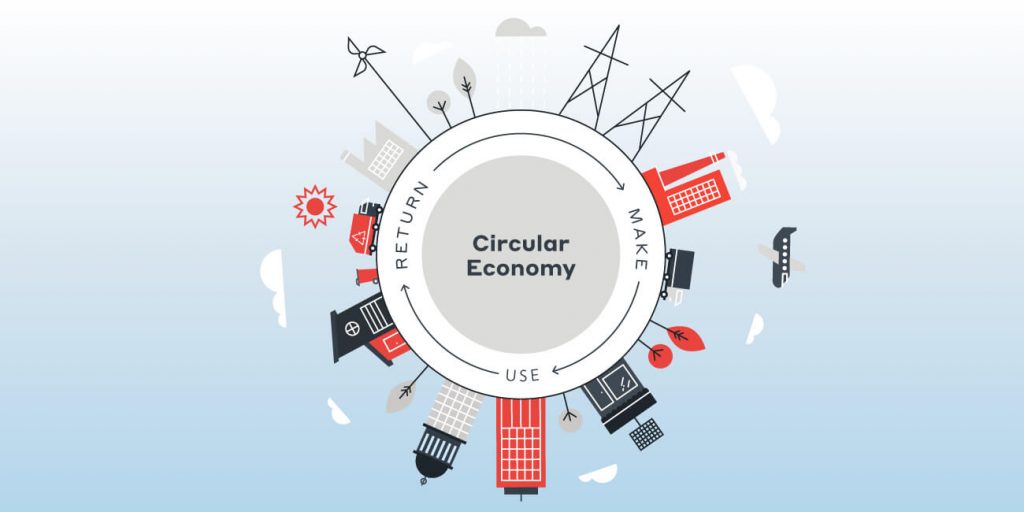Taking a closer look into what circularity means

Our planet, and our worldwide system of production and consumption are failing simultaneously. How can we reform both at the same time:
“Circularity is the largest business opportunity ever seen by our species. The leaders in the economic future will be people who will understand by design that we can create perpetual assets and optimize them to create businesses that thrive.” -William McDonough on the circular economic model.
How circularity is helping businesses thrive in 2019
We can change how we view packaging and delivery:
https://www.youtube.com/watch?v=yJaklD4WZmA#action=share
We can reuse and return:
What can you do?
Take a closer look into what circularity could mean to these three businesses when considering the ways you can apply your ideas regarding circular economy.
Andritz
Andritz is a service based business for replacing spare and ware parts. Andritz relies on their digital catalog for every aspect of their business including: businesses browsing for parts, businesses inquiring about a quote for specific part(s), submitting a purchase order and finalizing transactions and quick delivery.
What circularity could mean for Andritz:
How can aspects of the circular economic business model such as: built-to-last, built-to-repair, built-to-remanufacture and/or built-to-recycle be applied to the manufacturing of parts acquired through the digital business catalog. How can Andritz also include circularity during the digital process to interest manufacturers pursuing lower waste and energy consumption?
Where does Andritz require innovative ideas for improvement? Andritz operates by moving the customer between phases in a chain with handoffs between independently operating teams. When thinking about ways to use innovative tenets of a circular economy, consider the workflow for spare and wear parts. The search for the right parts is complicated for the customer. The amount of parts ordered varies between the customers. Delivery takes time and storage is an issue. Various software tools such as Enterprise Resource Planning (ERP), engineering tools and Outlook complicate things. How Can circularity be applied to the process of order and delivery, storage and the software needed?
Rauch Fruchstäfte:
Rauch Fruchstafte is a fruit juice company that has been around since 1919. The juice company has grown and changed and have become one of the premier fruit juice providers in Europe. As in any business providing foods or materials, the process of production and delivery is long and complicated. There is room for improvement in almost every sector within Rauch Fruchstafte. The challenged in front of Rauch Fruchstafte are: transportation and energy, communication and advertising and company image.
What circularity could mean for Rauch Fruchstafte:
How can Rauch Fruchstafte alter their business practices to include the major aspects of a circular economy? Aspects such as safe and clean production, reusable products and packaging, low consumption and energy usage and efficient transportation all could be incorporated for Rauch Fruchstafte.
Rauch Fruchstafte is looking to incorporate the circular economic business model. The company supplies fruits and distributes products, which takes a lot of logistical effort. The process of acquiring fruits and other ingredients, packaging the product, transporting the product to buyers and customers and disposing of the juice bottles all have room for improvement. Rauch Fruchstafte can improve not only in the production and provision of their product, but also in contributing to the lives of their customers. How can consumers of the juice see Rauch Fruchstafte as a digital companion of an experience. How is the drink of the year 2025 packaged? Is it packaged? How are customers interacting and identifying with the brand?
Your idea can be a new product, an innovative service or a new business model. There is lots of improvement to be made, how will you leave your mark on Rauch Fruchstafte?
Raiffeisenbank
Raiffeisenbank has recently been affected by the regulations set on all European banks. The legostics of the new open banking concept include the implementation of Payment Services Directive 2 (aka PSD2) where banks and other companies are opening up to third party providers via Application Programming Interfaces (APIs). There are many ways to improve open banking as it is in its early stages. Raiffeisenbank is looking to improve the customer experience, create new revenue streams, and create a sustainable service model for underserved markets.
What could circularity mean for Raiffeisenbank:
Raiffeisenbank is looking to use the circular economic model in order to improve their efficiency, sustainability and overall quality. Including the circular economic model within open banking could include prospects such as energy storage, advanced materials and an improved internet to make the circular economy a reality. Technology will also help financial institutions such as Raiffeisenbank gather additional data they need to examine the viability of business cases.


No Comments
Sorry, the comment form is closed at this time.